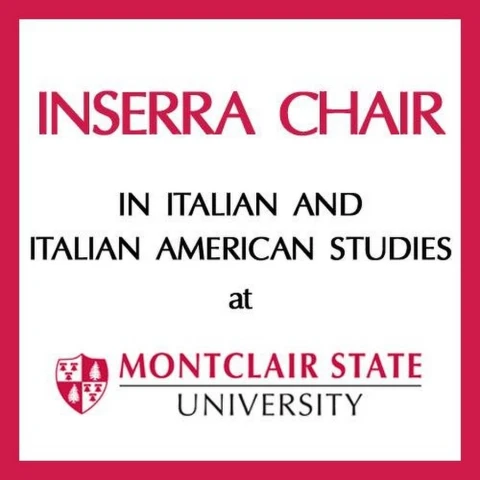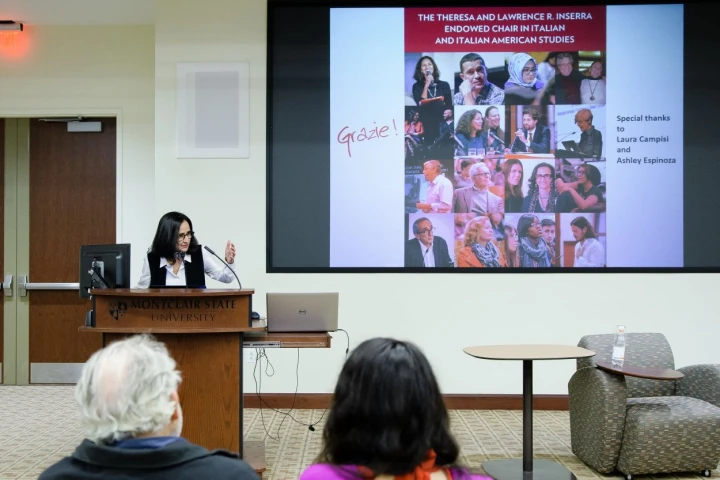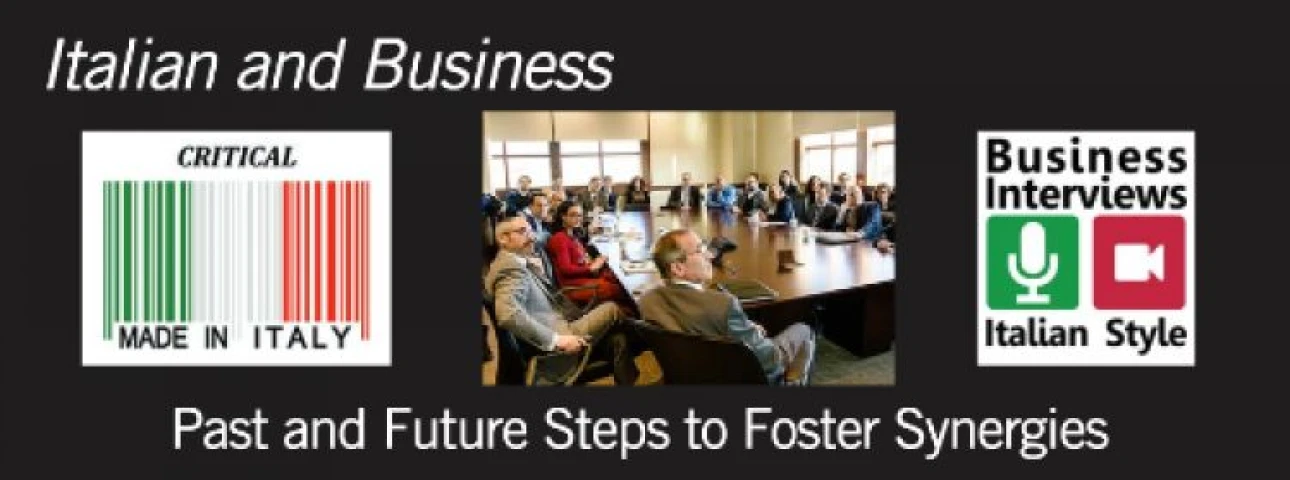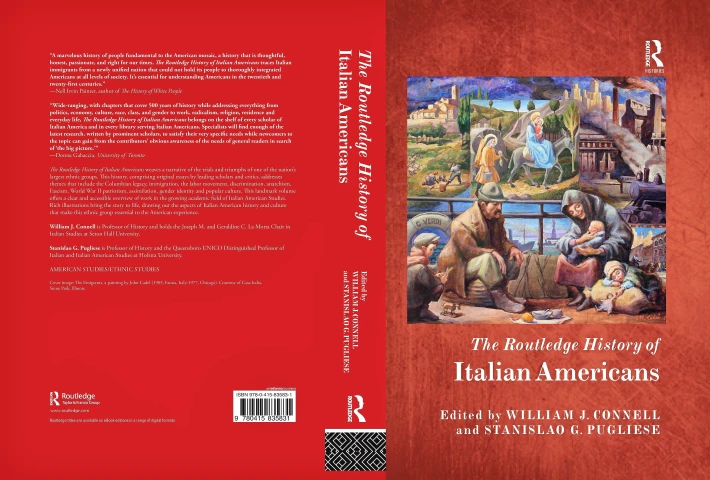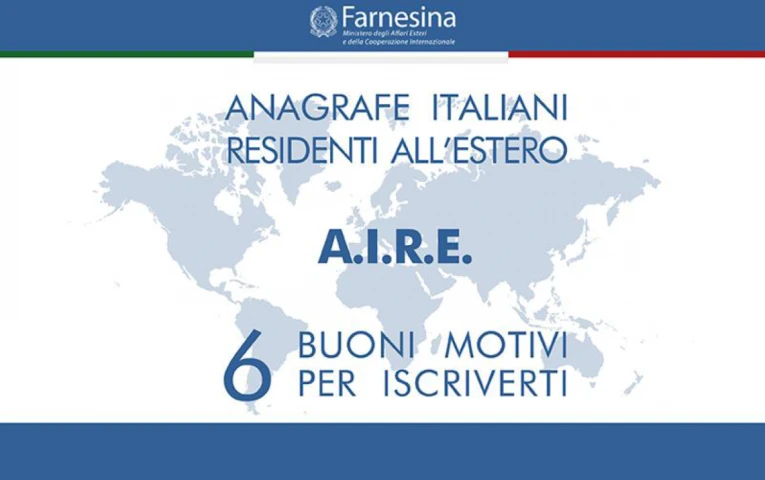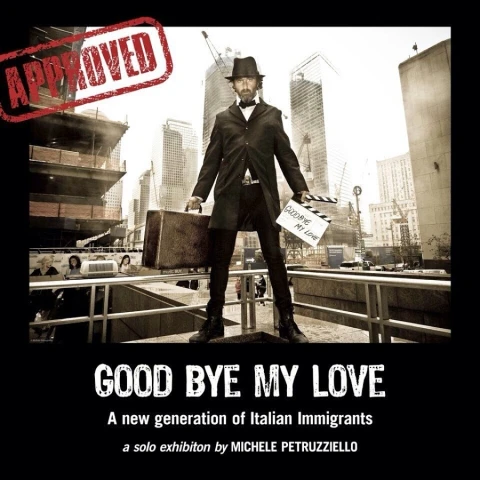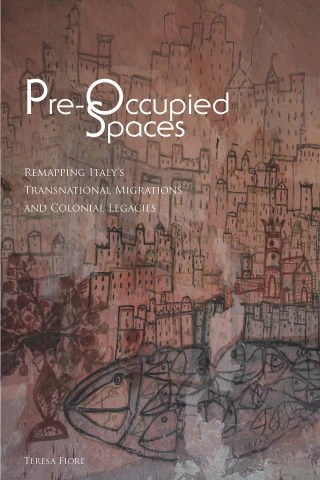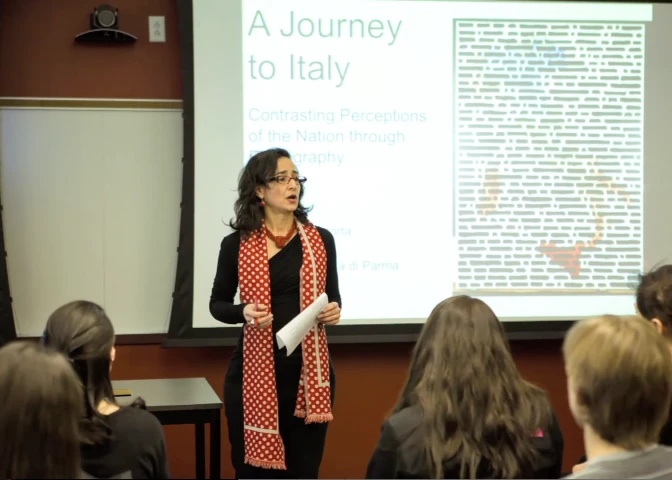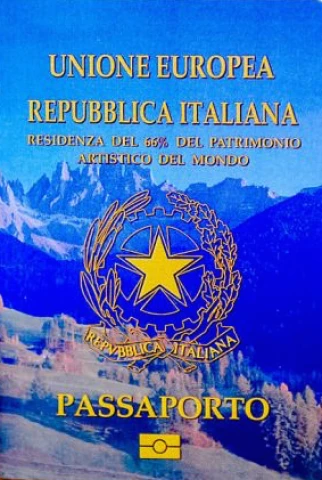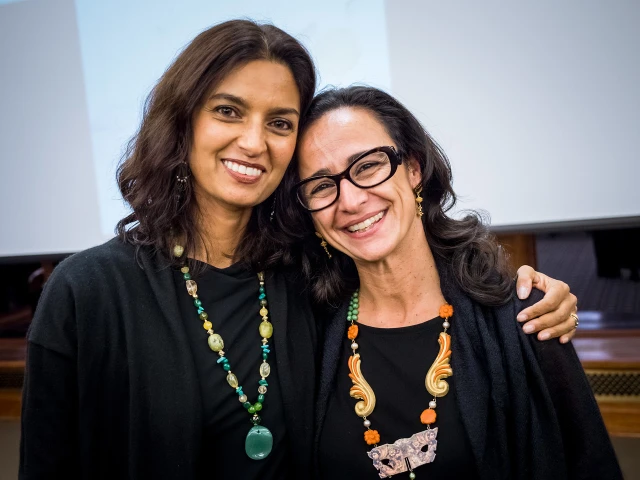Some scholars have studied the new Italian emigration to the United States. It's a very interesting topic, because it's obviously a different emigration in numbers, people and dynamics, compared to the one of 100 years ago: and yet, illuminating parallels can be identified. And the relationship between the heirs of the emigrants of the past, born Americans of Italian origin, and the new emigrants, born and raised in Italy, is also very interesting. We talk about this with a very welcome guest, Professor Teresa Fiore, who holds the Inserra Endowed Chair in Italian and Italian American Studies and has also written essays about this new emigration.
Professor Fiore, you hold the Inserra Chair in Italian and Italian American Studies, affiliated with the Italian Program and housed in the Modern Languages and Literatures Department at Montclair State University, NJ. Please tell us more about this wonderful program
This position is devoted to the promotion of Italian culture within a transnational perspective, sensitive to the history of migrations from and to Italy as well as the exchange of ideas, practices, and goods over the centuries in and out of Italy, with particular reference to the U.S. Since its inception in 2011, the Inserra Endowment has made possible on campus a vast array of activities: from the regular presentation of cultural events with established artists and scholars to the launching of innovative educational initiatives (scholarship-supported internships in the Made in Italy and Translation sectors as well as the only bridge course for high school students in the country), and the development of new research projects, including a current one about WWII, migration and food.
The Inserra Chair adopts an interdisciplinary approach that privileges collaborations on and off campus to enrich and challenge traditional perceptions of Italian culture. Unlike other centers of a similar nature that showcase Italian culture primarily for adult Italophiles, the Inserra Chair also actively engages young people throughout the education system in the appreciation of Italian culture produced within the country and in the spaces of its diaspora.
The cultural programs - an average of ten per year – are all free and open to the public and serve large audiences of both Montclair State University students and faculty and the residents of the NY/NJ area at large.
Over the years, major artists and scholars, from Italy and the U.S, including MacArthur Fellows, as well as Pulitzer-Prize, Ubu-Award and David-di-Donatello winners, have presented shows, lectures, exhibits, films, dance performances, etc. on a wide array of Italian/Italian American themes (Migrations; Futurism; Slow Food; Multi-Lingualism) and in many disciplines, from visual arts to music, fashion, art history, design, nutrition, architecture and history. U.S. and NJ premieres have been offered in both film and theater, with some being chosen as New York Times Critic’s Picks. Many programs have been presented in partnership with state, governmental, and top cultural institutions based in New Jersey, New York, Washington D.C., and Italy, and have been covered in the media.
Two major areas of focus for The Inserra Chair’s activities remain Italian Business/Made in Italy and Translation, which have defined an interesting balance between the traditional realm of arts and humanities and a more contemporary perception of Italy as a G7 country and one of the most industrialized in the world. In the former sector, the Inserra Chair has laid firm foundations for the development of pre-professional opportunities for students enriched by international experiences through establishing relationships with a network of local Italian companies, and by instituting a Critical Made in Italy series of panels and conversations. Other key areas of focus include programs about Sicily and about the relevance of the study of Italian.
You recently wrote a chapter of the amazing book The Routledge History of Italian Americans, edited by Stan Pugliese and Bill Connell. Your essay was called “Immigration from Italy since the 1990s”. Let’s start by asking you to please describe what AIRE is and a few general numbers about recent Italian emigration abroad
Yes. I have also written on the subject for New Italian Migrations to the United States, Vol. 2: Art and Culture Since 1945, edited by Laura E. Ruberto and Joseph Sciorra.
AIRE is the Record of Italians Residing Abroad. Technically, all Italians who reside in a new country for longer than 12 months should inform their nearest Consulate about their new address to be unregistered from the local records office in Italy and included in the AIRE list. This registration provides voting rights abroad for Italian elections and the ability to renew documents, among other privileges and services.
In reality, AIRE also includes those Italian citizens who are born abroad, and those who acquire the Italian citizenship in different ways whether through marriage or family origin. This latter aspect is very interesting to me because effectively it shows how Italy’s diasporic institutional vision combines both Italians living abroad and Italian descendants. This is quite surprising since the country has a complex relationship with its history of emigration, which is not an integral part of the common discourse nor the education system, and is not represented in a national museum, despite its gigantic size (roughly 27 million people left Italy between 1876-1976). Yet, AIRE produces, at least administratively, a shared space.
As of 2018, there are slightly above five million people registered in AIRE, interestingly equally distributed between Italians residing abroad and Italian descendants. In reality, it’s easier for the Consulates to keep track of people who acquire citizenship, since they are automatically added to AIRE, while Italians residing abroad have to actively decide to register. Estimates indicate that this latter group is substantially underrepresented: the number reflects half, if not one third, of the actual number of Italians who moved abroad. Italy’s contemporary emigration to the world, which is only growing (285,000 people in 2017 with a 50% growth over a decade according to Idos data), is vastly under-recorded in these statistics.
Why does the United States continue to play a fundamental role as a destination for Italian emigrants?
This country has always represented a magnet for immigrants for economic, cultural, and social reasons: profoundly interwoven with the fabric of Italian society due to cross-pollination in music, film and art; military and diplomatic alliances; as well, economic exchanges, the U.S. is a country to which Italians are also linked at an intimate level due to emigration.
Many Italian families have “a branch” in this country, by which I mean both descendants of relatives who emigrated a long time ago and/or people who have moved recently for study or work. The transnational nature of Italian families can be seen in many other parts of the world but it becomes particularly dynamic in the U.S. given the active circulation of people, goods, and projects across the ocean, in ways that are not comparable to Argentina or Canada, for example.
Despite the fact that a city like New York is much further away from Rome than London or Barcelona, and that it’s incredibly expensive and competitive, many people choose it to relocate for work and follow an opportunity or a dream, because it’s been done by so many before them. The tension towards and closeness to the U.S. has a long history.
It starts with a word that has always fascinated me, “La Merica,” (I am thinking of the beautiful 1911 short story by Maria Messina) where the name of an entire foreign country (erroneously referred to by the name of a continent, and ironically coined after an Italian, Amerigo Vespucci the explorer) is in part subsumed by its Italian article, and becomes a whole new space, made of dreams, fears, and expectations. It is a space that connects and separates at once.
Who are these new Italian immigrants to the US?
The common image of contemporary emigration as brain drain linked to academic research, managerial circulation, and artistic performance is only one piece of an intricate mosaic that includes also spouses who do not work, workers with common jobs, bi-national workers who rely on frequent trips or remote modes of work, and even people with unstable jobs in the restaurant business. Not to mention people who inhabit both categories, like being an artist and giving private classes under the table or working at a coffee shop to make a living.
While there are many glitzy stories that are often covered by the media to show the relevant role of Italy in today’s global economy and society, I am more interested in more invisible or less-talked about stories that reveal the complexities and contradictions of the emigration experience and hark back to older migrations (multiple circulation, struggles, precarious jobs) while revealing new traits (higher level of education even for simple jobs, the strong presence of women, reliance on fast transportation and easy communication). These new Italian immigrants are at once different and strangely similar to the old immigrants.
Some of the “new Italians” in the US we know are angry at Italy. Some of them are nostalgic. Some would like to come back. Some swear they’ll never do that. What’s your thought about this?
The perception of Italy, like that of any country of origin for immigrants, is part invention, part reality, and it is constantly mediated by outside factors like politics, and personal feelings, both subject to change over time. Italy is a place full of contradictions and it’s not surprising that there are strong reactions to it among emigrants, whether in terms of desire to return or to stay away from it. What interests me is the fact that despite its long history of emigration, Italy has not created the conditions for a circular diaspora, where return is a temporary or permanent option with specific incentives. The opportunity to go back for work-related projects or to move there would probably tame the strong feelings of nostalgia or rejection, and place Italy in a more realistic position able to counteract that of “a paradise inhabited by devils,” to borrow loosely from Benedetto Croce. The risk for the country is to become a frozen postcard, coveted by visitors, but not necessarily inviting or accessible to those who want to live and work there, including its own relocated people who entertain the idea of returning.
In your chapter of The Routledge History of Italian Americans, you tell three stories about new Italians, each representative of a pattern. The first one is about Clarissa Clò and, among other things, cites the role of the Italian Studies Departments.
Clarissa Clò’s story was important for me for two reasons. First of all, she is a professor of Italian, an often forgotten category in the discussion of both fairly recent Italian immigration to the U.S. and in the institutional discourse about Italian research in the U.S. The latter usually embraces scientists and inventors but quite systematically excludes the contribution of Italian Studies Departments, as if research about Italian artists and writers were not as relevant as that of chemistry or physics, when in actuality the cultural industry in Italy has a pivotal role. The erasure of the field from the public discourse glosses over the substantial contribution of professors of Italian Studies for the country: the promotion of the language and the culture, the hosting of Italian cultural events that often brings artists and scholars from Italy, and the various initiatives taking students to Italy or finding internships for them in Italy. These activities speak to the ambassador-like role of Italian Studies professors, which is not automatically the role of an Italian researcher in a U.S. university’s biology lab, for instance.
Clò’s story was also critical to talk about another silent story, that of emigration linked to sexuality: being gay in Italy has always been a harder experience than in the U.S. and today even more so than ever, at a time in which the “normative” family has become a reason to exclude and condemn. An overview of “new Italians” in the U.S. should then include Italians who chose this country to be able to have a family of their own, where adoption is an option rather than forced (complex and expensive) artificial insemination as it is in Italy. Clò’s American Dream is hardly conventional in this respect, and yet one of the many forms in which Italians are able to pursue not just professional but also personal gratification.
Davide’s story, instead, is about the problem of legal papers
Davide’s visa expires, and overnight he becomes “irregular.” Since he refuses to return to Italy, due to a general aversion to the country, his only option is that of securing an arranged marriage, which he is able to do, and then exercise enough patience through the process with his “wife” and the red tape. His story, which has a happy ending with first a green card and citizenship later, offered me the opportunity to delve into the world of undocumented Italians abroad (roughly 500,000 according to a 2014 study), the majority of which live in the U.S., and NYC in particular. Several aspects of this phenomenon are striking to me: Italy has become obsessed with “clandestini” but oddly ignores the fact that some recent Italian emigrants find themselves in an undocumented position when they overstay their visas. Also, since it considers Italians as professionally integrated immigrants, the U.S. does not see them as protagonists of “underground” lives related to the lack of papers, and as such does not check on them as much as other groups regarding arranged marriages or ID’s. Finally, Italians were historically labeled as WOPs (without official papers), a derogatory nickname that created the stigma of non-belonging all the way to WWII. It’s ironic that today, even among educated and financially secure Italians, there are “WOPs.”
Finally, Michele Petruzziello’s story lets you address the issue of the talented Italian professionals who cross the ocean looking for a better future
Michele’s personal story is that of a freelancer who was able to secure and maintain work in the U.S. from the beginning in his own sector, TV news footage production. Yet, as a person who came in touch with many “new Italians abroad,” he became aware of the broad diversity characterizing the current inbound flow, and has been very intent on documenting it as a photographer but with an original twist. His Italian immigrants are actors, teachers, journalists, business owners, freelancing artists, professionals holding secure as well as precarious positions: Michele places them in spaces and with props that are linked to their work, but dresses them as past immigrants going through Ellis Island in the early 1900s. The juxtaposition between their current experience and the clothes that they wear - made by Michele himself - creates a mental short-circuit. Regardless of their economic position, these people “wear” the legacy of the immigrant experience, and represent its most recent instantiation as part of a continuum.
From our particular point of view here in Italy, even if improvements have definitely been made, we see a mutual acceptance of the cultural differences between Italians recently emigrated to the US and the Italian Americans. Maybe, sometimes, they seem like two branches of a family that rarely speak to each other and mix respect for the same roots with hostility for a different way of living these roots. What do you think?
This issue has become a bit of an impasse and, like all impasses, needs some new actions to create a more productive discourse. I have always found Italians’ limited knowledge of the country’s emigration abroad with its internal mechanisms, practices and symbols a considerable obstacle in generating mutual understanding and a reinforcer of stereotypes. This learning process may show current immigrants how they are not so dissimilar from old ones: I am thinking in particular about the region-based associations that are popping up among professionals.
At the same time, Italian Americans, and in particular those active in organizations, could benefit from attending cultural, rather than social, events in order to be more connected with contemporary Italy, or even more knowledgeable about their own history. This self- and reciprocal education on the part of both groups is crucial, I believe, since pre-judicial positions can only exacerbate the distance. I find that projects of common interest like the promotion of Italian programs and departments, which Italian Americans have generously supported, has proven to be a common ground, and further building on it can only prove beneficial for all involved, possibly by embracing Italian American people in their 30s-50s, rather than primarily university students and retirees active in volunteering.
Your recent awarded book Pre-Occupied Spaces: Remapping Italy's Transnational Migrations and Colonial Legacies describes Italy as a unique laboratory to rethink national belonging at large in our era of massive demographic mobility, discovering “traces of globalization in a past that may hold interesting lessons about inclusiveness for the present”. It is a very interesting and delicate topic for our country. Please tell us more about this book
By linking Italy’s long history of emigration to all continents in the world up to today, contemporary transnational migrations directed toward it, as well as the country’s colonial legacies, Pre-Occupied Spaces remaps the country according to the notion and experience of multi-directional mobility. No other country can claim this experience of inbound and outbound flows as contiguous or overlapping phenomena over a period of only 150 years, and this is why I refer to Italy as a unique laboratory to discuss national belonging.
The book rethinks Italy’s formation and development on a transnational map including Egypt, Argentina, France, Ethiopia and the U.S. as places where Italians relocated or from where people have left to relocate to Italy as part of (post)-colonial and (multiple) migratory routes. While providing historical and sociological contextualizations, I offer a close analysis of literary, filmic, and musical texts by both canonical and new authors that show the interconnections between e-/immigration and (post)colonialism. In organizing the texts thematically around three clusters focused on space (Travel, Living, and Work), the book aims at demonstrating how immigration in Italy today is pre-occupied by its past emigration and colonialism, and in this sense it stresses commonalities and dispels preoccupations. In a world of plural migrations and, at the same time intensified anxiety about migrants and an acute desire for national “purity”, Pre-occupied Spaces is fostering interesting exchanges on mobility in opposition to today’s crisis-filled public discourse.
Alcuni studiosi si sono occupati della nuova emigrazione italiana negli Stati Uniti. E' un tema molto interessante, perché si tratta ovviamente di una emigrazione differente per numeri, persone e dinamiche, rispetto a quella di 100 anni fa: eppure si possono individuare dei parallelismi illuminanti. Ed è anche molto interessante il rapporto tra gli eredi degli emigranti di una volta, nati Americani di origine italiana, e i nuovi emigrati, nati e cresciuti in Italia. Ne parliamo con un ospite molto gradito, la professoressa Teresa Fiore, titolare dell’Inserra Endowed Chair in Italian and Italian American Studies e ha anche scritto saggi su questa nuova emigrazione.
Professoressa Fiore, lei è titolare dell’Inserra Endowed Chair in Italian and Italian American Studies, affiliata all’Italian Program e ospitata presso il Modern Languages and Literatures Department della Montclair State University, in New Jersey. La preghiamo di descriverci questo meraviglioso programma di studi
Questa posizione è dedicata alla promozione della cultura italiana in una prospettiva transnazionale, sensibile alla storia delle migrazioni da e verso l'Italia e allo scambio di idee, pratiche e beni nel corso dei secoli all'interno e all'esterno dell'Italia, con particolare riferimento agli Stati Uniti. Fin dalla sua nascita nel 2011, l'Inserra Endowment ha reso possibile al campus una vasta gamma di attività: dalla regolare presentazione di eventi culturali con artisti e studiosi affermati al lancio di iniziative educative innovative (stage sostenuti da borse di studio nel settore del Made in Italy e della traduzione, nonché l'unico corso ponte per studenti delle scuole superiori del Paese), e lo sviluppo di nuovi progetti di ricerca, tra cui uno attuale sulla seconda guerra mondiale, la migrazione e il cibo.
L’Inserra Chair adotta un approccio interdisciplinare che privilegia le collaborazioni all'interno e all'esterno del campus per arricchire e sfidare le percezioni tradizionali della cultura italiana. A differenza di altri centri di natura simile che propongono la cultura italiana soprattutto per gli italofili adulti, l’Inserra Chair coinvolge attivamente anche i giovani di tutto il sistema educativo nell'apprezzamento della cultura italiana prodotta nel paese e negli spazi della diaspora.
I programmi culturali - una media di dieci all'anno - sono tutti gratuiti e aperti al pubblico e servono un vasto pubblico di studenti e docenti della Montclair State University e dei residenti dell'area di New York e del New Jersey in generale.
Nel corso degli anni, grandi artisti e studiosi, italiani e statunitensi, tra cui alcuni MacArthur Fellows, nonché alcuni vincitori del Premio Pulitzer, dell’Ubu Award e del David di Donatello, hanno presentato spettacoli, conferenze, mostre, film, spettacoli di danza, ecc. su una vasta gamma di temi italo americani (Migrazioni; Futurismo; Slow Food; Multilinguismo) e in molte discipline, dalle arti visive alla musica, moda, storia dell'arte, design, nutrizione, architettura e storia. Abbiamo organizzato prime cinematografiche e teatrali inedite in America o nel New Jersey, alcune delle quali sono state scelte dal New York Times Critic's Picks. Molti programmi sono stati presentati in collaborazione con istituzioni statali, governative e culturali di alto livello con sede nel New Jersey, New York, Washington DC e in Italia. I media hanno coperto tanti eventi nel tempo.
Due grandi aree di interesse per le attività dell’Inserra Chair rimangono l'Italian Business/Made in Italy e la Traduzione, che hanno definito un interessante equilibrio tra l'ambito tradizionale delle arti e delle discipline umanistiche e una percezione più contemporanea dell'Italia come paese del G7 e uno dei più industrializzati al mondo. Nel primo settore, l’Inserra Chair ha gettato solide basi per lo sviluppo di opportunità pre-professionali per gli studenti, arricchite da esperienze internazionali attraverso l'instaurazione di relazioni con una rete di sedi locali di aziende italiane e l'istituzione di una serie di panel e conversazioni sul Made in Italy. Altre aree chiave di interesse sono i programmi sulla Sicilia e sulla rilevanza dello studio della lingua italiana.
Lei ha recentemente scritto un capitolo dello straordinario libro The Routledge History of Italian Americans, a cura di Stan Pugliese e Bill Connell. Il suo saggio si chiama "Immigration from Italy since the 1990s". Inizierei chiedendole di descrivere che cos'è l'AIRE e alcuni numeri generali sulla recente emigrazione italiana all'estero
Si, ho anche approfondito l’argomento su New Italian Migrations to the United States, Vol. 2: Art and Culture Since 1945, a cura di Laura E. Ruberto e Joseph Sciorra.
L’AIRE è l’Associazione degli italiani residenti all'estero. Tecnicamente, tutti gli italiani che risiedono in un nuovo paese per più di 12 mesi devono comunicare al Consolato più vicino il loro nuovo indirizzo per essere cancellati dall'anagrafe locale in Italia e inseriti nell'elenco AIRE. Questa iscrizione garantisce il diritto di voto all'estero per le elezioni italiane e la possibilità di rinnovare i documenti, tra gli altri privilegi e servizi.
In realtà, l’AIRE comprende anche i cittadini italiani nati all'estero e quelli che acquisiscono la cittadinanza italiana in modi diversi sia per matrimonio che per origine familiare. Quest'ultimo aspetto è per me molto interessante perché dimostra efficacemente come la visione istituzionale italiana della propria diaspora coniughi sia gli italiani all'estero che i discendenti italiani. Questo è abbastanza sorprendente perché il Paese ha un rapporto complesso con la sua storia di emigrazione, che non è parte integrante del discorso comune né del sistema educativo, e non è rappresentato in un museo nazionale, nonostante le sue dimensioni gigantesche (circa 27 milioni di persone hanno lasciato l'Italia tra il 1876-1976). Tuttavia, l'AIRE produce, almeno amministrativamente, uno spazio condiviso.
A partire dal 2018, gli iscritti all'AIRE sono poco più di cinque milioni di persone, distribuite equamente, il che è interessante, tra italiani residenti all'estero e discendenti italiani. In realtà, è più facile per i Consolati raccogliere i dati relativi alle persone delle persone che acquistano la cittadinanza, in quanto si aggiungono automaticamente all'AIRE, mentre gli italiani residenti all'estero devono decidere attivamente di registrarsi. Le stime indicano che quest'ultimo gruppo è sostanzialmente sottorappresentato: il numero riflette la metà, se non un terzo, del numero effettivo di italiani che si sono trasferiti all'estero. L'emigrazione contemporanea dell'Italia nel mondo, che è in crescita (285.000 persone nel 2017 con un aumento del 50% in un decennio secondo i dati Idos), è ampiamente sottostimata in queste statistiche.
Perché gli Stati Uniti continuano ad essere una delle mete preferite come destinazione degli emigranti italiani?
Questo Paese ha sempre rappresentato una calamita per gli immigrati per ragioni economiche, culturali e sociali: è profondamente intrecciato con il tessuto della società italiana per le reciproche influenze nella musica, nel cinema e nell’arte; per le alleanze militari e diplomatiche, per gli scambi economici. Gli Stati Uniti sono un Paese a cui gli italiani sono legati anche a livello intimo a causa dell'emigrazione.
Molte famiglie italiane hanno "un ramo" in America, intendendo sia i discendenti di parenti emigrati da tempo sia persone che si sono trasferite di recente per motivi di studio o di lavoro. La natura transnazionale delle famiglie italiane è visibile in molte altre parti del mondo, ma diventa particolarmente dinamica negli Stati Uniti, data la circolazione attiva di persone, merci e progetti oltreoceano, in modi che non sono paragonabili, ad esempio, all'Argentina o al Canada.
Nonostante una città come New York sia molto più lontana da Roma di Londra o Barcellona, e che sia incredibilmente costosa e competitiva, molti la scelgono per trasferirsi per lavoro e seguire un'opportunità o un sogno, perché è stato fatto da tanti prima di loro. La preferenza e la affinità verso gli Stati Uniti hanno una lunga storia.
Ha le sue radici in una parola una parola che mi ha sempre affascinato, "La Merica", (penso al bellissimo racconto del 1911 di Maria Messina) dove il nome di un intero paese straniero (erroneamente indicato con il nome di un continente, e ironicamente coniato ispirandosi ad un italiano, l’esploratore Amerigo Vespucci) viene in parte inglobato dal suo articolo italiano, e diventa uno spazio tutto nuovo, fatto di sogni, paure e aspettative. È uno spazio che si collega e separa allo stesso tempo.
Chi sono questi nuovi immigrati italiani negli Stati Uniti?
L'immagine comune dell'emigrazione contemporanea come fuga di cervelli legata alla ricerca accademica, alla circolazione manageriale e alla performance artistica è solo un pezzo di un mosaico intricato che comprende anche coniugi che non lavorano, lavoratori comuni, professionisti binazionali che fanno affidamento su frequenti viaggi o modalità di lavoro a distanza, e anche persone con lavori instabili nel settore della ristorazione. Per non parlare delle persone che fanno parte di più di una di queste categorie, come essere un artista e dare lezioni private o lavorare in una caffetteria per guadagnarsi da vivere.
Mentre ci sono molte storie appariscenti che sono spesso coperte dai media per mostrare il ruolo rilevante dell'Italia nell'economia e nella società globale di oggi, io sono invece interessata a storie più invisibili o meno discusse che rivelano la complessità e le contraddizioni dell'esperienza migratoria e rimandano a migrazioni più vecchie (spostamenti multipli, lotte, lavori precari) mentre rivelano nuovi tratti (livello di istruzione superiore anche per lavori semplici, forte presenza femminile, dipendenza dai trasporti veloci e facile comunicazione). Questi nuovi immigrati italiani sono allo stesso tempo diversi e stranamente simili ai vecchi immigrati.
Sappiamo che alcuni dei "nuovi italiani" negli Stati Uniti sono arrabbiati con l'Italia. Alcuni di loro ne hanno nostalgia. Alcuni vorrebbero tornare. Alcuni giurano che non lo faranno mai. Cosa ne pensa di questo?
La percezione dell'Italia, come quella di qualsiasi paese di origine degli immigrati, è in parte invenzione, in parte realtà, ed è costantemente mediata da fattori esterni come la politica e i sentimenti personali, entrambi soggetti a cambiamenti nel tempo. L'Italia è un luogo pieno di contraddizioni e non sorprende che ci siano forti reazioni tra gli emigranti, sia in termini di voglia di tornare o di starne fuori. Quello che mi interessa è il fatto che, nonostante la sua lunga storia di emigrazione, l'Italia non ha creato le condizioni per una diaspora circolare, dove il ritorno sia un'opzione temporanea o permanente con incentivi specifici. L'opportunità di tornare per progetti di lavoro o di trasferirsi lì probabilmente smusserebbe i forti sentimenti di nostalgia o di rifiuto, e darebbe all'Italia un'immagine più realistica in grado di contrastare quella di "un paradiso abitato da diavoli", per citare liberamente Benedetto Croce. Il rischio per il Paese è quello di diventare una cartolina congelata, ambita dai visitatori, ma non necessariamente invitante o accessibile a chi vuole viverci e lavorare, comprese le sue stesse persone trasferitesi che intrattengono l'idea del ritorno.
Nel suo capitolo di The Routledge History of Italian Americans, lei racconta tre storie di nuovi italiani, ognuno dei quali rappresentativo di un modello. La prima riguarda Clarissa Clò e, tra le altre cose, cita il ruolo dei Dipartimenti di Studi Italiani.
La storia di Clarissa Clò è stata importante per me per due motivi. In primo luogo, è professoressa di italiano, categoria spesso dimenticata sia nella discussione sull'immigrazione italiana negli Stati Uniti che nel discorso istituzionale sulla ricerca italiana negli Stati Uniti. Quest'ultima di solito comprende scienziati e inventori, ma esclude sistematicamente il contributo dei Dipartimenti di Studi Italiani, come se la ricerca su artisti e scrittori italiani non fosse così rilevante come quella di chimica o fisica, quando in realtà l'industria culturale in Italia ha un ruolo centrale. La cancellazione del campo dal discorso pubblico nasconde il sostanziale contributo che i professori di Studi Italiani danno al Paese: la promozione della lingua e della cultura, la presentazione di eventi culturali italiani che spesso accolgono artisti e studiosi dall'Italia, e le varie iniziative che portano gli studenti in Italia o trovano stage per loro in Italia. Queste attività parlano del ruolo di ambasciatori dei professori di studi italiani, che non è necessariamente il ruolo svolto in maniera automatica da un ricercatore italiano in un laboratorio di biologia di un'università statunitense, ad esempio.
L’esperienza di Clarissa Clò è stata importante anche per parlare di un'altra storia silenziosa, quella dell'emigrazione legata alla sessualità: essere gay in Italia è sempre stata un'esperienza più difficile che negli Stati Uniti e oggi più che mai, in un momento in cui la famiglia "tradizionale" è diventata motivo di esclusione e condanna. Una panoramica dei "nuovi italiani" negli Stati Uniti dovrebbe pertanto includere gli italiani che hanno scelto questo Paese per poter avere una famiglia propria, dove l'adozione è un'opzione piuttosto che l'inseminazione artificiale forzata (complessa e costosa) come in Italia. L'American Dream di Clò non è affatto convenzionale in questo senso, eppure è una delle tante forme in cui gli italiani sono in grado di perseguire non solo la gratificazione professionale ma anche personale.
La storia di Davide, invece, riguarda il problema dei documenti legali
Il visto di Davide scade e da un giorno all’altro lui diventa "irregolare". Poiché si rifiuta di tornare in Italia, a causa di una generale avversione verso il paese, la sua unica opzione è quella del matrimonio combinato, cosa che riesce a fare, per poi trovarsi a pazientare a lungo sia bei rapporti con la “moglie” che nella gestione della burocrazia. La sua storia, che ha un lieto fine con la carta verde prima e la cittadinanza poi, mi ha offerto l'opportunità di addentrarmi nel mondo degli italiani senza documenti all'estero (circa 500.000 secondo uno studio del 2014), la maggior parte dei quali vive negli Stati Uniti, a New York in particolare. Molti aspetti di questo fenomeno mi colpiscono: L'Italia è diventata ossessionata dai "clandestini", ma stranamente ignora il fatto che alcuni emigrati italiani recenti si trovano in una posizione irregolare quando il visto scade. Inoltre, poiché considerano gli italiani come immigrati integrati professionalmente, gli Stati Uniti non li vedono come protagonisti di vite "clandestine" legate alla mancanza di documenti, e come tali non li controllano tanto quanto altri gruppi per quanto riguarda i matrimoni combinati o i documenti d'identità. Infine, gli italiani sono stati storicamente etichettati come WOP (without papers, senza documenti ufficiali), un soprannome dispregiativo che ha creato lo stigma della non-appartenenza fino alla seconda guerra mondiale. E' ironico che oggi, anche tra gli italiani istruiti e finanziariamente sicuri, ci siano dei "WOP".
Infine, la storia di Michele Petruzziello permette di affrontare il tema dei talentuosi professionisti italiani che attraversano l'oceano alla ricerca di un futuro migliore.
La storia personale di Michele è quella di un freelance che ha saputo trovare e mantenere lavoro negli Stati Uniti fin dall'inizio nel proprio settore, la produzione di filmati televisivi. Tuttavia, come persona che è entrata in contatto con molti "nuovi italiani all'estero", si è reso conto dell'ampia diversità che caratterizza l'attuale flusso in entrata, ed si è molto impegnato a documentarlo come fotografo, ma con un tocco originale. I suoi immigrati italiani sono attori, insegnanti, giornalisti, imprenditori, artisti freelance, professionisti in posizioni sicure e precarie: Michele li colloca in spazi e con oggetti di scena legati al loro lavoro, ma li veste come se fossero immigrati passati attraverso Ellis Island all'inizio del Novecento. L'accostamento tra la loro esperienza attuale e gli abiti che indossano - realizzati dallo stesso Michele - crea un cortocircuito mentale. A prescindere dalla loro posizione economica, queste persone "indossano" l'eredità dell'esperienza immigrata e ne rappresentano l'istanza più recente come parte di un continuum.
Dal nostro particolare punto di vista qui in Italia, anche se sicuramente sono stati fatti dei miglioramenti, vediamo una reciproca accettazione delle differenze culturali tra gli italiani recentemente emigrati negli Stati Uniti e gli italoamericani. Forse, a volte, sembrano due rami di una famiglia che raramente si parlano e mescolano il rispetto per le stesse radici con l'ostilità per un diverso modo di vivere queste radici. Cosa ne pensi?
Questo tema è diventato un po' impasse e, come tale, ha bisogno di nuove azioni per creare un discorso più produttivo. Ho sempre trovato che la limitata conoscenza degli italiani dell'emigrazione all'estero, con i suoi meccanismi, le sue pratiche e i suoi simboli, dà vita non solo ad un notevole ostacolo nel generare una comprensione reciproca, ma anche ad un rafforzamento degli stereotipi. Questo processo di apprendimento può mostrare agli immigrati attuali come non siano così diversi da quelli del passato: penso in particolare alle associazioni regionali che si stanno formando tra i professionisti.
Allo stesso tempo gli italoamericani, e in particolare quelli attivi nelle organizzazioni, potrebbero beneficiare della partecipazione ad eventi culturali o sociali, per essere più connessi con l'Italia contemporanea, o anche più consapevoli della propria storia. Questa auto-educazione reciproca da parte di entrambi i gruppi è cruciale, credo, perché i pregiudizi non possono che esacerbare la distanza. Trovo che progetti di interesse comune come la promozione di programmi e dipartimenti italiani, che gli italoamericani hanno generosamente sostenuto, si è dimostrato un terreno comune, e il suo ulteriore sviluppo non può che essere vantaggioso per tutte le parti coinvolte, magari abbracciando gli italoamericani della fascia d’età tra i 30 e i 50 anni, oltre agli studenti universitari e ai pensionati attivi nel volontariato.
Il suo recente e premiato libro Pre-Occupied Spaces: Remapping Italy's Transnational Migrations and Colonial Legacies descrive l'Italia come un laboratorio unico per ripensare l'appartenenza nazionale in generale nella nostra epoca di massiccia mobilità demografica, scoprendo "tracce di globalizzazione in un passato che può contenere interessanti lezioni sull'inclusività per il presente". Si tratta di un tema molto interessante e delicato per il nostro Paese. Ci dice di più su questo libro?
Collegando la lunga storia dell'emigrazione italiana in tutti i continenti del mondo fino ad oggi, le migrazioni transnazionali contemporanee dirette in Italia, così come l'eredità coloniale del Paese, il libro ridisegna l’Italia secondo il concetto e l'esperienza della mobilità multidirezionale. Nessun altro paese può vantare questa esperienza di flussi in entrata e in uscita come fenomeni contigui o sovrapposti in un periodo di soli 150 anni, ed è per questo che mi riferisco all'Italia come a un laboratorio unico per discutere di appartenenza nazionale.
Il libro ripensa la formazione e lo sviluppo dell'Italia su una mappa transnazionale che include Egitto, Argentina, Francia, Etiopia e Stati Uniti come luoghi dove gli italiani si sono trasferiti o da dove sono partiti per trasferirsi in Italia nell'ambito di rotte (multi) migratorie e (post) coloniali. Nel fornire contestualizzazioni storiche e sociologiche, offro un'attenta analisi di testi letterari, filmici e musicali di autori canonici e nuovi che mostrano le interconnessioni tra e-/immigrazione e (post) colonialismo. Organizzando i testi tematici intorno a tre cluster focalizzati sullo spazio (il viaggio, lo spazio di vita, il lavoro), il libro mira a dimostrare come l'immigrazione in Italia sia oggi preoccupata dall'emigrazione e dal colonialismo del passato, e in questo senso sottolinea i punti in comune e dissipa le preoccupazioni. In un mondo di migrazioni plurali che allo stesso tempo intensifica l'ansia per i migranti e l'acuto desiderio di "purezza" nazionale, il libro favorisce interessanti scambi sulla mobilità in opposizione all'odierno discorso pubblico concentrato sulla crisi.



